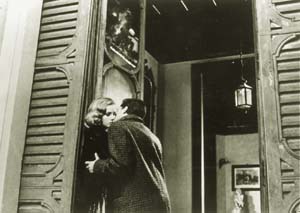Behind the Green Walls
Languorous Object of Desire: Dominque Sanda's diffident aristocrat tempts fate in Vittorio De Sica's "The Garden of the Finzi-Continis."
An Italian family tries to hold back the forces of history in its secret 'Garden'
By Richard von Busack
EVERYONE KNOWS the story of the frog immersed in water in a pot over the stove, with the temperature gradually increasing, until it is parboiled without even knowing it. The tale raises questions: Was this the same ill-fated frog that gave the scorpion a ride? Was there a lid on the pot? Because if there was, whether the frog objected or not doesn't matter, does it? The denizens of The Garden of the Finzi-Continis, Vittorio De Sica's famous 1971 drama (now re-released in a new print) are easily likened to the famous frog; as they drift isolated from history outside their walls, they never know it's too late for them until the secret police invade their mansion.
A rich family from Ferrara, the Finzi-Continis own a walled estate the size of a small botanical garden; their daughter, Micol (Dominique Sanda), exerts the same sort of fascination on suitors that Daisy Buchanan held for Jay Gatsby. The poorer and somewhat immature Giorgio (Lino Capolicchio) pines for her--as does the camera, searching out the riddle behind her famously enigmatic face. Unwarmed by Giorgio's ardor, Micol doesn't even bother to cover herself when the rain makes her tennis blouse transparent. All Giorgio can do is tread that sad road of the sensitive young man who watches coarser boys succeed where he fails. The strange languor of the Finzi-Continis, impervious even to air-raid sirens, continues as the edicts of the Mussolini government restrict the behavior of non-Aryans--for there is one thing the gilded family and the struggling Giorgio have in common: they are all Jews.
De Sica, who was 70 when he made the film, delivers this intriguing, lovely and evocative story as nostalgia in the best taste; his imagery is full of the silhouettes of palms, the flashing legs and gleaming wheels of bicyclists. Here was a sensibility bled to despair by a hundred television commercials of the time. This past is a garden we can't enter again--the last image is of a padlocked gate. And Sanda's Micol, satin-draped, with plucked eyebrows, is both, as a character says, "sufficiently whorish" and a fascinating example of the love object that recedes even as you fawn over her. To question her motives would be like questioning an expensive China doll.
What makes The Garden of the Finzi-Continis worth seeing is how subtly De Sica handles Micol. Even when she does something especially cruel--rebuking Giorgio in a hardhearted way for spying on her--she is decidedly not a bitch. Her peculiar behavior and the troubling quality of the walled-in family are not quite explained, and therefore all the more haunting. Why did these aristocrats let their world go to hell? If you asked the Finzi-Continis, you'd get the same answer you'd get if you asked friends why they live in a "gated community"--the modern-day version of the Finzi-Continis' dreaming garden.
[ Metro | Metroactive Central | Archives ]
This page was designed and created by the Boulevards team.

Charles Peterson
The Garden of the Finzi-Continis (R; 95 min.), directed by Vittorio De Sica, written by Cesare Zavattini, Vittorio Bonicelli and Ogo Pirro, based on the novel by Giorgio Bassani, photographed by Ennio Guarnieri and starring Dominque Sanda and Lino Capolicchio.
From the November 27-December 4, 1996 issue of Metro
Copyright © 1996 Metro Publishing, Inc.
![[Metroactive Movies]](/movies/gifs/movies468.gif)